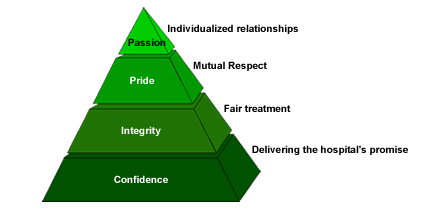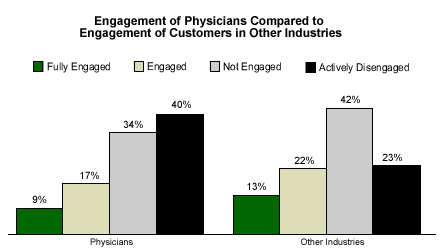Today's hospitals must not only earn their patients' loyalty, but also that of their physicians. The reason is simple: High-quality physicians draw patients to their hospitals and affiliated doctors refer patients to hospitals for outpatient procedures. Without loyal physicians, there are no loyal patients. For this reason, the loyalty of a hospital's medical staff is a prerequisite to a hospital's success.
Traditionally, strategies to increase physician loyalty have focused on improvements in procedural efficiency -- for example, in the smooth functioning of administrative services and admissions, or the ease with which physicians can access the tools and equipment they need. While such improvements are necessary for all hospitals, they do not necessarily lead to long-term physician loyalty. Just ask any department manager how long a physician stays happy after receiving a new, "absolutely essential" piece of technology. In my experience, the contentment lasts anywhere from 20 minutes to 24 hours before the physician decides he or she needs something else.
The question remains: What do hospitals need to do to achieve lasting physician loyalty?
Engaging Physicians
║┌┴¤═° has conducted hundreds of surveys of physicians in healthcare organizations across the country. Our research shows that to achieve true loyalty from physicians, hospitals must understand the complete picture of physician engagement, viewing the physician as a "customer" of the facility with which he or she is affiliated.
Physicians' engagement with their hospitals consists of a combination of attitudinal loyalty and emotional attachment. ║┌┴¤═° measures the loyalty component of physicians using three specific items:
- overall satisfaction with the hospital
- likelihood to continue on the medical staff
- likelihood to recommend the hospital
Emotional attachment is measured using eight questions that fall into a four-level hierarchy:

Using the responses from 2,900 physicians, ║┌┴¤═° calculated average levels of physician engagement with their hospitals, and then compared those figures to customer engagement measured in other industries.

The percentages of "fully engaged," "engaged," and "not engaged" physicians lag behind those of other industries. "Fully engaged" physicians -- those who are strongly attached and loyal -- are the most valuable to a hospital. "Engaged" physicians are emotionally attached, but not attitudinally loyal to the hospital. "Not engaged" physicians are emotionally and attitudinally neutral, and attach no positive associations to the hospital.
The largest gap between physicians and customers in other industries appears in the "actively disengaged" category. Two in five physicians (40%) are "actively disengaged," compared to just under a quarter (23%) of customers in other industries who are actively disengaged. Actively disengaged physicians are emotionally detached and antagonistic toward their hospitals.
Why Are Doctors Emotionally Disengaged?
Among professionals like physicians, ║┌┴¤═° has discovered two key dimensions within engagement. The first dimension is engagement with the profession -- how physicians see themselves within the context of what is expected of them as doctors. Managed care and government intervention have changed the role of American physicians, leading to disengagement with the profession. Disengagement in this dimension can also affect engagement on the second dimension -- engagement between physicians and their hospitals. Levels of communication, trust, fairness, and respect influence the relationship between physicians and their hospitals.
While there may be little that individual hospitals can do to improve physician engagement with their profession, they can certainly improve the relationship between the hospital and the physician by increasing communication, trust, fairness, and respect. The second part of this series will focus specifically on what hospitals can do to improve physician engagement.